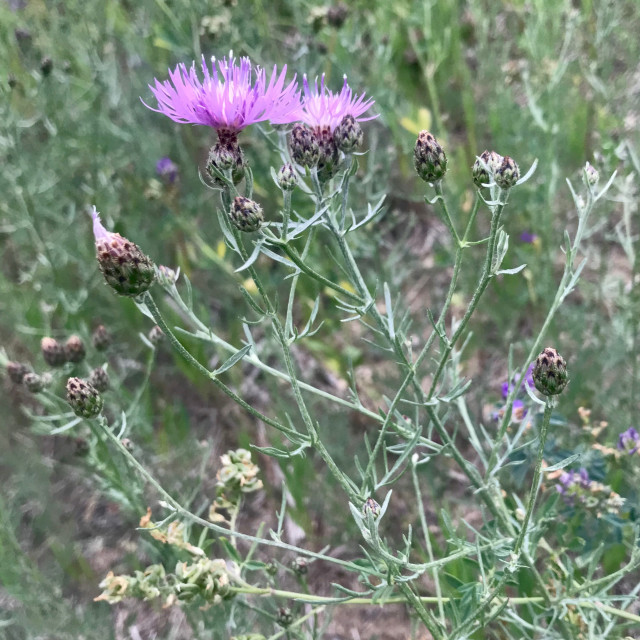COMMON NAME
Spotted knapweed
SCIENTIFIC NAME
Centaurea stoebe
Plant family
Aster (Asteraceae)
Plant group
Wildflowers and Herbs
Spotted knapweed is an invasive herbaceous biennial or short lived perennial plant with light pinkish purple flowers.
21 reports
16+
OBSERVERS
21+
OBSERVATIONS
Identification hints
Spotted knapweed is an invasive plant that tends to become abundant so you'll likely find more than one plant at a time. The flowers are pinkish purple and thistle-like, and while the stems are rough to the touch they are not as prickly as thistles. Spotted knapweed looks similar to other relatives including Alpine knapweed.
Did you know?
At the end of the second or final year of growth, the plant breaks off into a tumble weed which helps distribute the seeds. The plant was likely accidentally introduced to the United States with alfalfa, and was originally recorded in the Pacific Northwest in the late 1800s.
DISTRIBUTION IN TH U.S.
Alabama
,
Arkansas
,
Arizona
,
California
,
Colorado
,
Connecticut
,
Delaware
,
Florida
,
Georgia
,
Hawaii
,
Iowa
,
Idaho
,
Illinois
,
Indiana
,
Kansas
,
Kentucky
,
Louisiana
,
Massachusetts
,
Maryland
,
Maine
,
Michigan
,
Minnesota
,
Missouri
,
Montana
,
North Carolina
,
North Dakota
,
Nebraska
,
New Hampshire
,
New Jersey
,
New Mexico
,
Nevada
,
New York
,
Ohio
,
Oregon
,
Pennsylvania
,
Rhode Island
,
South Carolina
,
South Dakota
,
Tennessee
,
Utah
,
Virginia
,
Vermont
,
Washington
,
Wisconsin
,
West Virginia
,
Wyoming
HABITAT
Spotted knapweed was introduced from Eurasia and is now distributed throughout most of North America. It is found on open disturbed sites, industrial sites, agricultural fields, pastures, roadsides, grasslands, open woods, mountains, and stream banks. It will readily invade lawns and stands of undisturbed native bunchgrass.
ATTRIBUTES
Leaves
The leaves are once or twice divided into deep lobes and are generally pale green to blue-gray in color. In the first year, plants only produce a basal rosette (no stem), and they produce a flowering stem with alternate leaves the following year. Leaves at the base of the plant are larger, up to 8 inches long and 2 inches wide, but they get smaller as they ascend the stem. Flowering plants have multiple stems emerging from the base of the plant.
Flowers
Florets are arranged in flowering heads and are pink to light purple, rarely white, sometimes with the center of the head lighter in color than the outer ring. Flowering heads are between 3/4"-1" in diameter and a single plant has many flowering heads borne on the tips of the branched stems. Pollen is typically white, and styles are branched.
Fruits
Seed heads are about half an inch long and contain tiny brown seeds that are oval in shape and attached to a short tuft of bristles which help with wind dispersal. Each plant can produce tens of thousands of seeds.
Bloom Time
Numerous flowers are produced from early June to November depending on the location. In northern areas it flowers until snowfall or the soil freezes. The seeds may germinate from spring through early fall.
See Menu
- 2021 Chicago Botanic Garden. All Rights Reserved.
-
Creative Commons
BY-NC-SA 4.0 - Terms of Use
- Privacy Policy
- Data Sharing and Citation Policies
- 2021 Chicago Botanic Garden. All Rights Reserved.



